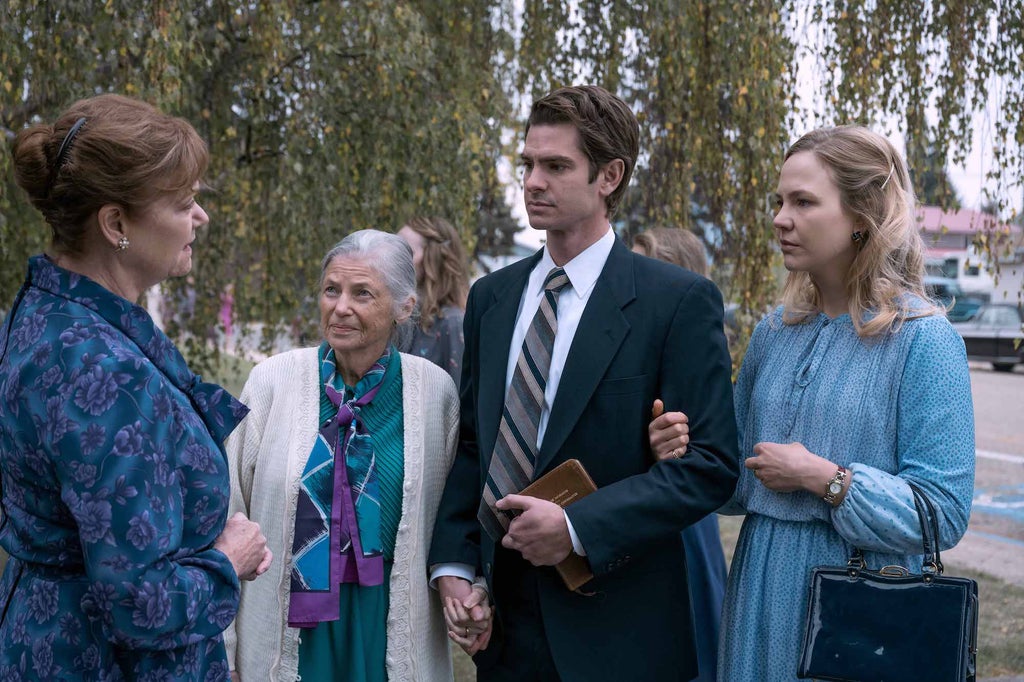At some point, true crime TV became synonymous with shocking depictions of real-life events. While books and podcasts encourage audiences to use their imagination about the brutality endured by (mostly female) victims, the switch to long, drawn-out television series brought the horror alive, masquerading as a much-needed element of ‘truth’. Like the friend who can be cruel in the name of being ‘honest’, these series became progressively jarring in their depictions of violence with seemingly little thought for the very real people who were subjected to it in the first place.
For viewers who have resigned themselves to the fact that these harsh visuals are intrinsic to the genre, a new series is proving that the power of performance can be an even more effective storytelling tool. Inspired by Jon Krakauer’s book of the same name, Disney+’s Under The Banner Of Heaven unravels the true story of a 1984 double homicide involving members of the Mormon church. Starring Andrew Garfield in the lead role, the story is told through the lens of fictionalised detective Jeb Pyre as he confronts the gruesome details of the case alongside fellow detective Bill Taba (Gil Birmingham).

The case in question is the murder of 24-year-old Brenda Wright Lafferty and her baby daughter, Erica. A member of the Church of Jesus Christ of Latter-Day Saints, Brenda (Daisy Edgar-Jones) is shown to be a woman wholly committed to her religion but with ambitions beyond those of her peers. Determined to break into the world of news reporting, Brenda moves to Salt Lake City to attend university. There she meets her future husband, Allen Lafferty, at church. His family, described as a Southern equivalent of the Kennedys, are a powerful force within the Latter-Day Saints community, where reputation is everything.
The family’s status makes the case even more shocking to the local townspeople, the majority of whom are also devout members of the Mormon faith, including Detective Pyre. Receiving a call from the police officers on the scene, Pyre takes a moment to kneel and pray with his family before he leaves to investigate. When he arrives at the property he stops to console a shaken police officer before stepping into the home with caution. The carpet is covered in blood and, in the corner, we see an obstructed body lying on the ground before it fades into a blurry frame. We follow Pyre’s line of movement as he notices children’s toys on the floor and becomes overwhelmed with horror.

As he steps around the corner, he finds the remnants of a phone wire in a pool of blood in the kitchen. Trying to compose himself, he notices the framed photos of Brenda on the wall and his memory flits back to days at church before he arrives at a closed bedroom door. A bloody handprint on the door frame forces him to investigate the contents of the room. Gingerly pushing open the door with the tip of a pen, we see a flicker of a mobile above a crib before the camera turns back to a shaken, grief-stricken Pyre.
This near-silent opening sequence proves just how powerful moments like this can be when the focus remains the actor’s reaction. Played with unwavering earnestness by Garfield, the scene captures the gravity of the situation without being salacious, sitting with the brutality without ever truly showing it. Garfield’s performance echoes the type of candidness seen in True Detective or Mindhunter, making you sit up and engage with the weight of the story without it feeling like any of the moments were written to add drama.
Although the scene itself contains shots that would be regarded as shocking, the sequence feels like an intentional step towards more careful storytelling. Even as the details of the story reveal themselves through the eyes of two men, the series manages to give Brenda agency in her own narrative. Admittedly, this assessment is based solely on the first episode but the use of memory and flashback sequences allows Brenda to feel like a central character rather than a plot device used to propel the series forward.

You might argue that this is the bare minimum that writers should be doing when working with sensitive material but in a genre that so often goes for shock value over substance it’s important to recognise how these stories can be adapted to be impactful rather than indecent. Bolstered by stellar performances from Garfield, Birmingham and Edgar-Jones, Under The Banner Of Heaven is a rare example of how true crime TV can recapture sensitivity in an oversaturated space.
Under The Banner Of Heaven is streaming on Disney+ from 27th July
Like what you see? How about some more R29 goodness, right here?
True Crime Podcasts Highlighting Victims Of Colour